What Is the 1941 Lincoln Penny Made Of?
The 1941 Lincoln Penny is a one-cent coin having a face value of $0.01. The penny is made of 95% copper and 5% tin and zinc mixture. The weight of the bronze cent is 3.11 grams, while its diameter is 19.05 mm with a plain edge.
As the US entered World War II in 1941, copper and tin, both used in the coin, were in short supply. So the cents produced in 1943 were made out of zinc-coated steel. These coins were known as the “war-time” cents.
Initially, the design of the Lincoln cent was a flying eagle by sculptor Augustus Saint-Gaudens. However, according to the law, an eagle couldn’t be put on the cent. So Saint-Gaudens submitted another design of Liberty to then-President Roosevelt. He ordered that the Indian design be created for the eagles instead. Since Saint-Gaudens was seriously ill with cancer at that time and later died, the sculptor failed to submit another design.
So the inception to redesign the cent came to Roosevelt, seeing that many citizens were proposing to have President Lincoln be on the cent to commemorate his centennial birth anniversary in 1909. So as an honor for his fellow Republicans, Roosevelt commissioned sculptor Victor David Brenner to create a design of Lincoln’s bust on the penny in late 1908.
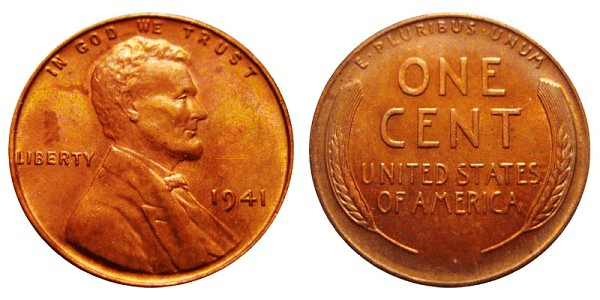
When you look at the obverse side, you can find the profile of Lincoln facing right. The following inscriptions were also written:
- IN GOD WE TRUST
- LIBERTY
- 1941
On the reverse side bears the elements of two ears of durum wheat. These inscriptions were also included:
- IN GOD WE TRUST
- LIBERTY
- 1941
Brenner’s two stalks of wheat made the cent known as the “wheat penny”. This design was used for the coin mintage for 49 years, from 1909 to 1958. But in 1959, the wheat reverse was replaced by a depiction of the Lincoln Memorial.
1941 Lincoln Penny Varieties
One of the U.S. coins that were made in billions for just one series is the Lincoln Penny. The U.S. mints in Denver, Philadelphia, and San Francisco produced about 1.1 billion of four varieties of the 1941 Lincoln Penny: 1941-D, 1941-P, 1941-S, and 1941-Proof.
Here’s a table that will give you an overview of the 1941 Lincoln penny varieties along with their mintage figure:
| Variety | Mint Location | Mintage |
| 1941 D Lincoln Wheat Penny | Denver | 128,700,000 |
| 1941 S Lincoln Wheat Penny | San Francisco | 92,360,000 |
| 1941 P Lincoln Wheat Penny | Philadelphia | 887,018,000 |
| 1941 Proof Lincoln Wheat Penny | Philadelphia | 21,100 |
| Total | 1,108,099,100 |
Since the pennies were massively produced, some error coins were made. Let’s take a look at some of these varieties below:
1941 D Lincoln Penny
Year of minting: 1941
Mint Mark: D
Place of minting: Denver
Quantity produced: 128,700,000
Face Value: $0.01 (one cent)
Price: $0.15 to $3 (circulated condition)
Mass: 3.11 grams
Edge: Plain
Designer: Victor David Brenner
Composition: 95% copper and 5% tin and zinc
Diameter: 19.05 mm
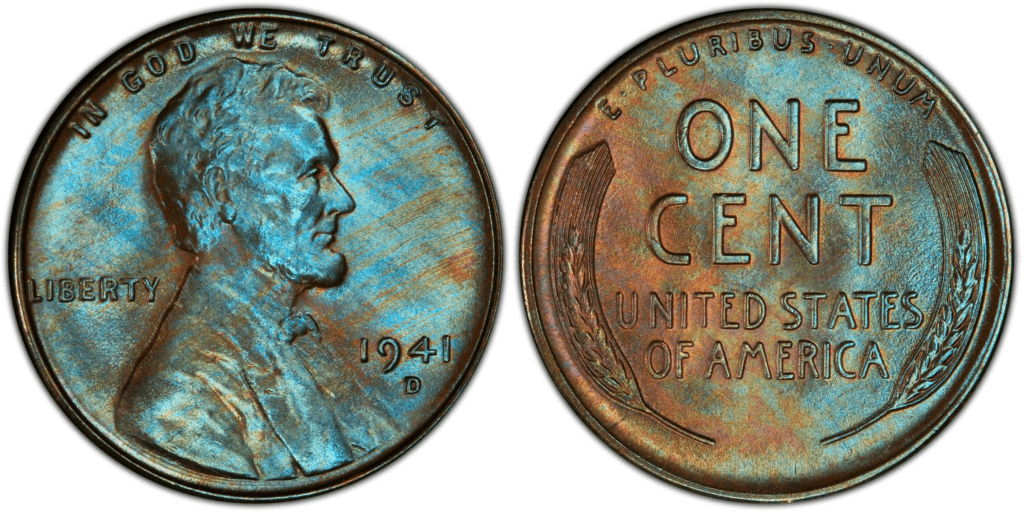
The number of mintages for over 128 million makes the 1941-D Lincoln penny very common in all grades. Nowadays, you can still find a thousand samples in MS66 Red condition. Some fine pieces in MS67 Red are also still existing. This 1941 series in D varieties has a strong strike and is attractive to many coin collectors.
1941 P Lincoln Penny
Year of minting: 1941
Mint Mark: No mint mark
Place of minting: Philadelphia
Quantity produced: 887,018,000
Face Value: $0.01 (one cent)
Price: $0.15 to $1.50 (circulated condition)
Mass: 3.11 grams
Edge: Plain
Designer: Victor David Brenner
Composition: 95% copper and 5% tin and zinc
Diameter: 19.05 mm
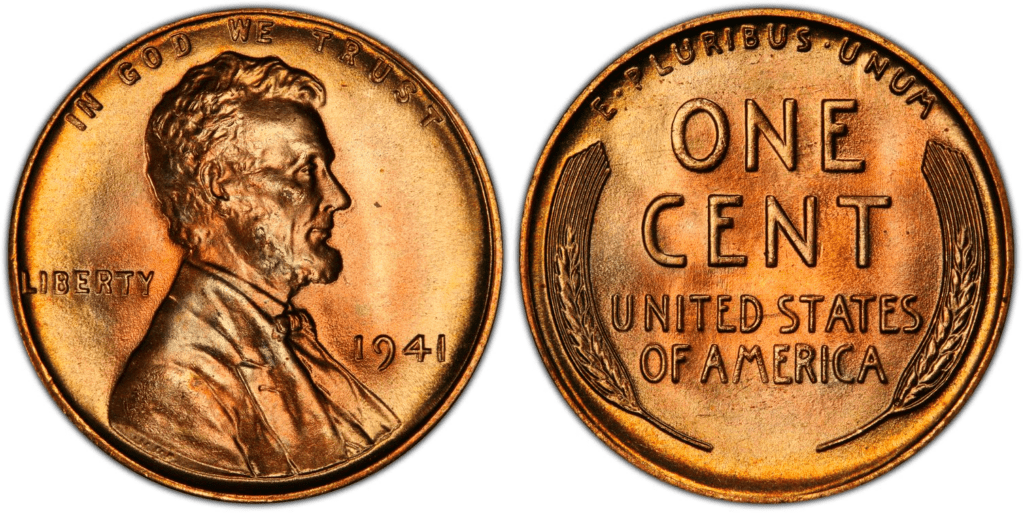
The 1941 Lincoln coins minted in Philadelphia is the 6th highest mintage with more than 887 million wheat pennies struck. As a result, the rare coins in this variety are abundant. In addition, many 1941-P have been released for circulation.
1941 S Lincoln Penny
Year of minting: 1941
Mint Mark: S
Place of minting: San Francisco
Quantity produced: 92,360,000
Face Value: $0.01 (one cent)
Price: $0.15 to $3 (circulated condition)
Mass: 3.11 grams
Edge: Plain
Designer: Victor David Brenner
Composition: 95% copper and 5% tin and zinc
Diameter: 19.05 mm

The San Francisco mint struck over 92 million 1941-S Lincoln pennies. This mintage is higher than the previous series. Overall, the 1941-S is relatively available in circulated and uncirculated conditions. However, coin collectors find getting 1941-S in higher Mint State grades challenging.
1941 Lincoln Penny (Proof)
Year of minting: 1941
Mint Mark: No mint mark
Place of minting: Philadelphia
Quantity produced: 21,100
Face Value: $0.01 (one cent)
Price: $15.75 or more (circulated condition)
Mass: 3.11 grams
Edge: Plain
Designer: Victor David Brenner
Composition: 95% copper and 5% tin and zinc
Diameter: 19.05 mm
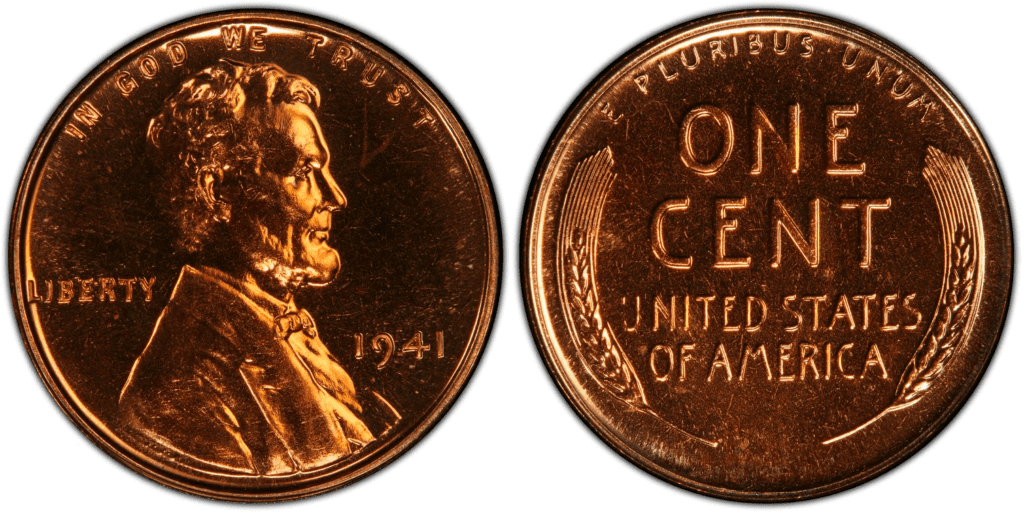
The Philadelphia minted over 21 thousand 1941 Lincoln proof cents. Though fewer in number, these are not particularly scarce. PR64 to PR66 conditions are still available but with noticeable spotting, discoloration, and stains.
List Of 1941 Lincoln Penny Errors
With over 1.1 billion Lincoln pennies being produced in 1941, you could expect that a mint made coins incorrectly. So these are usually called mint error coins. However, because of its uniqueness, it excites some collectors to collect unique coins with distinct appearances.
The error coins are made due to factors that affect the minting process, such as deteriorating machines, malfunctioning equipment, or human intervention or error.
Below are a couple of samples of the 1941 Lincoln Penny with errors:
Lamination Flaw/ Split planchet
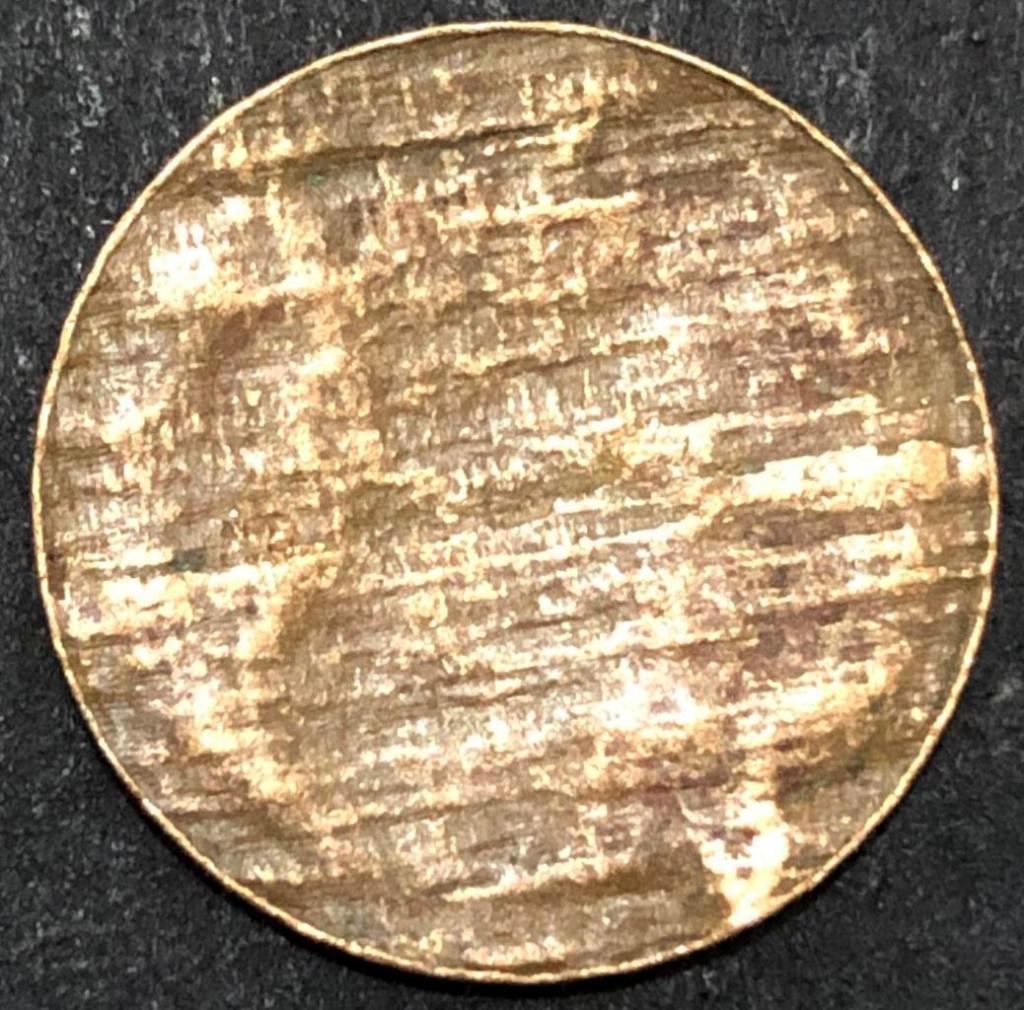
The above example has a lamination error that results from cracks or flakes on the surface of a planchet. In addition, the contaminants in the alloy can cause the metal to separate on the planchet. Lamination errors occur before or after the strike.
Doubled Die on the obverse or DDO
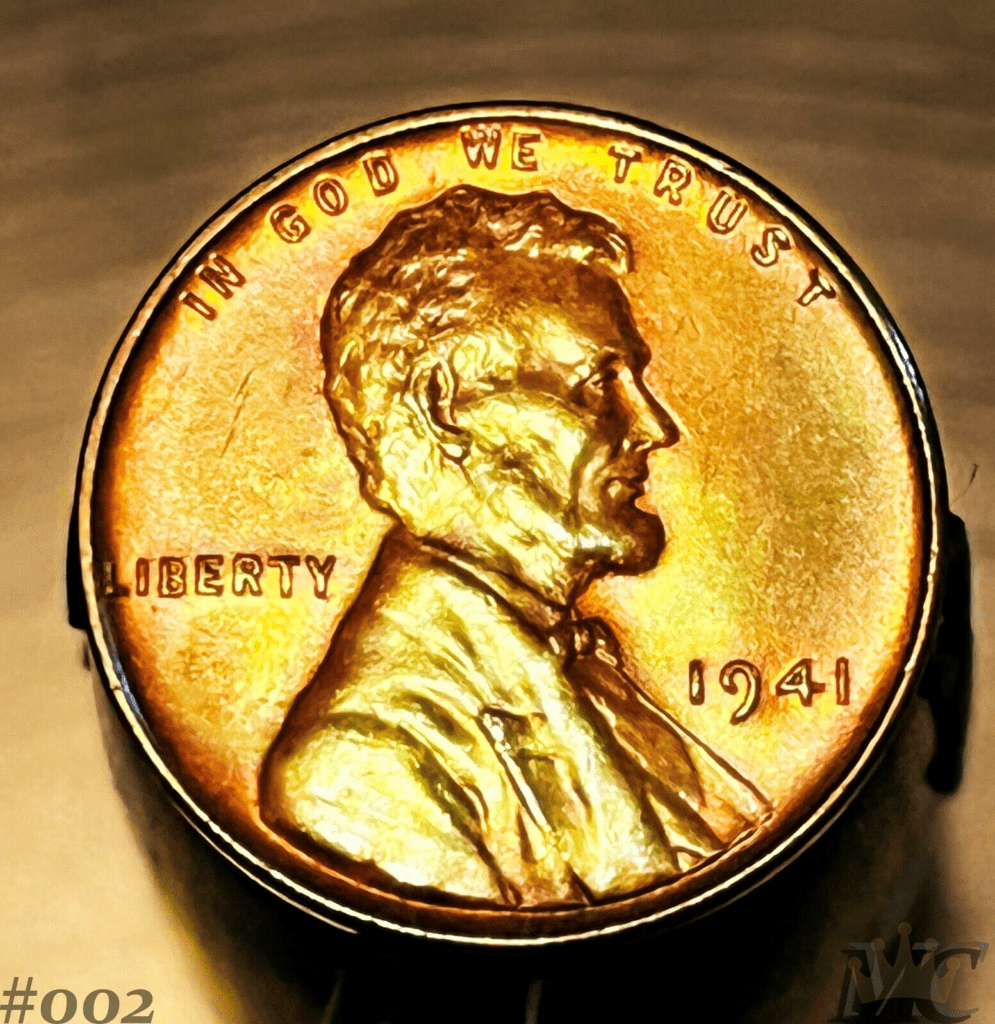
When a coin die is not manufactured correctly, it will result in a doubled die error. It will show two images on a single coin die. In the example above, the double die is on the obverse; that’s why it’s coded as DDO.
How Much Is the 1941 Lincoln Penny Worth Today?
Depending on the condition and variety of the coin, the 1941 Lincoln Penny is approximately priced between $0.02 and $0.04 for circulated pennies. At the same time, uncirculated pieces can be sold for roughly $1.71 to $2.30.
Meanwhile, the melt value of a 1941 Lincoln coin is generally based on the metal of the copper, tin, and zinc when melted down. Today, the melt value of a 1941 Lincoln Penny is estimated at $0.0282.
Looking at the melt value or face value, you would soon see that the 1941 pennies aren’t worth that much. You might even doubt whether it is worth anything or not.
However, you should not let that prevent you from looking for precious 1941 pennies. Some 1941 1-cent coins are worth more than their face and melt value.
Take a look at this chart that shows you the auction records for each variety based on the PCGS website:
| Coin | Condition | Grade | Sold date | Sold by | Value |
| 1941 Proof Lincoln Penny | Superb Gem Uncirculated | PR 67 (Red) | November 1, 2013 | Heritage Auctions | $28,200
|
| 1941 D Lincoln Penny | Superb Gem Uncirculated | MS 68 (Red) | January 2, 2023 | eBay | $6,600 |
| 1941 P Lincoln Penny | Gem Uncirculated | MS 65 (Red) | November 1, 2013 | Heritage Auctions | $4,994 |
| 1941 P Lincoln Penny | Superb Gem Uncirculated | MS 67+ (Red) | July 5, 2016 | David Lawrence RC | $1,908 |
How Coins are Graded
The Sheldon Scale is used by numismatists to provide a numerical value to coins. The Sheldon Scale goes from poor (P-1) to perfect mint state (P-1) (MS-70). Coins were originally evaluated using words to reflect their condition (Good, Fair, Excellent, Etc.). Unfortunately, coin collectors and dealers had different ideas about what each of these terms represent.
Professional numismatists joined together in the 1970s and established CoinGrading standards. These numismatists now assign grades at key places on the seventy-point scale, using the most regularly utilized numeric points in conjunction with the original adjective grade. The following are the most common coin grades:
- (P-1) Poor – Indistinguishable and probably damaged; if used, must have a date and mintmark; otherwise, rather battered.
- (FR-2) Fair – Nearly smooth, but without the damage that a coin graded Poor often possesses. The coin must have enough detail to be identified.
- (G-4) Fair – Inscriptions have merged into the rims in some areas, and important elements have been mostly erased.
- (VG-8) Very Good- A little weathered, but all of the primary design elements are visible, albeit faintly. There is little if any, central detail left.
- (F-12) Good – The item is very worn, yet the wear is even, and the overall design details stand out clearly. Rims are almost completely isolated from the field.
- (VF-20) Very Fine – Moderately weathered, with some finer features still visible. The motto or all letters of LIBERTY are readable. Both sides of the coin have entire rims that are separated from the field.
- (EF-40) Extremely Fine – Gently used; all gadgets are visible, and the most important ones are bold. The finer details are bold and clear, however, light wear may be seen.
- (AU-50) Uncirculated – Slight evidence of wear on the coin’s design’s high points; may have contact marks; eye appeal should be adequate.
- (AU-58) Uncirculated Choice – Slight traces of wear, no severe contact marks, almost full mint shine, and great eye appeal.
- (MS-60) Mint State Basal – Strictly uncirculated; no indication of wear on the coin’s highest points, but an unsightly coin with reduced luster, visible contact marks, hairlines, and other flaws.
- (MS-63) Mint State Acceptable – Uncirculated, but with contact scratches and nicks, little reduced shine, but otherwise appealing appearance. The strike is weak to average.
- (MS-65) Mint State Choice – Uncirculated with great mint shine, very little contact blemishes, and exceptional eye appeal. The strike is unusually severe.
- (MS-68) Mint State Premium Quality – Uncirculated with superb luster, no obvious contact marks to the naked eye, and exceptional eye appeal. The strike is quick and appealing.
- (MS-69) Almost Perfect Mint State – Uncirculated with perfect brilliance, a sharp and appealing strike, and extremely good eye appeal. A near-perfect coin with minor imperfections in the planchet, strike, and contact markings (seen only under 8x magnification).
- (MS-70) Mint State Perfect – Under 8x magnification, there are no tiny imperfections discernible; the strike is crisp, and the coin is perfectly centered on a beautiful planchet. Rarely seen on a coin, this coin is bright and whole, with original luster and exceptional eye appeal.
Where To Buy Or Sell 1941 Lincoln Penny?
There are many ways to buy and sell your 1941 Lincoln Penny collections. The most popular is online. The ones that come first to mind are eBay, Amazon, Etsy, and other known online stores. Register to these sites if you like the online platform’s convenience.
Of course, you can never go wrong if you visit physical stores like pawn shops and coin or antique stores. If you need professional advice, contact the experts from PCGS and NGC for consultation.
FAQs
Is a 1941 penny rare?
Given that the 1941 Lincoln penny mintage is over 1.1 billion, these coins are not rare or valuable. However, uncirculated or MS-grade coins are rare, like those with MS67 or MS68 grades. There are also 1941 Lincoln Pennies with mint errors much rarer than regular strikes.
How do I know if my 1941 penny is worth anything?
The best way to check whether your 1941 Lincoln Penny collection is worth a premium is to have it graded. You can put a reasonable tag price for graded coins compared to those that are not.
What is the error on a 1941 penny?
You can name a few regarding 1941 Lincoln mint error coins. These are but are not limited to doubled die, lamination flaw, broadstrike, clipped planchet, and many more.
